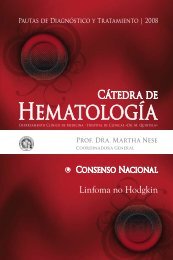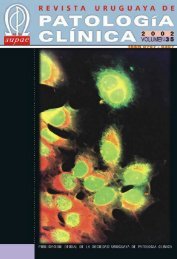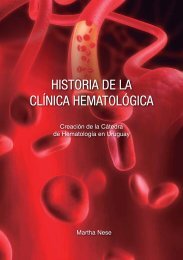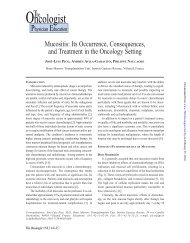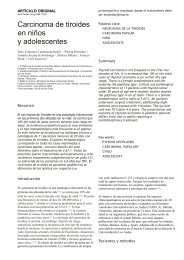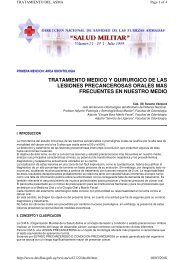A Phase I/II study of weekly paclitaxel and 3 days of high dose oral ...
A Phase I/II study of weekly paclitaxel and 3 days of high dose oral ...
A Phase I/II study of weekly paclitaxel and 3 days of high dose oral ...
Create successful ePaper yourself
Turn your PDF publications into a flip-book with our unique Google optimized e-Paper software.
Weekly Paclitaxel/Estramustine in HRPC/Ferrari et al. 2043TABLE 4Prostate Specific Antigen Response by CohortCohort Paclitaxel Estramustine No.Treatmentdiscontinued Progressed StablePSA decline> 50%Intent to treatresponse (%)I 40 600 3 0 3 0 0 0 <strong>of</strong> 3<strong>II</strong> 60 900 3 1 1 0 1 1 <strong>of</strong> 3<strong>II</strong><strong>II</strong> 75 900 6 1 0 1 4 4 <strong>of</strong> 6IV 90 900 6 2 0 0 4 4 <strong>of</strong> 6Total — — 18 4 4 1 9 9 <strong>of</strong> 18 (50)PSA: prostate specific antigen. 50%. Because the group <strong>of</strong> patients in Cohorts <strong>II</strong>–IVreceived a <strong>dose</strong> <strong>of</strong> estramustine 1.5 times greater thanCohort I, <strong>and</strong> this alone may have affected the PSAresponse irrespective <strong>of</strong> the <strong>dose</strong> <strong>of</strong> <strong>paclitaxel</strong>, we alsoanalyzed them as a group. The intent-to-treat analysisshowed that 9 <strong>of</strong> 15 patients (60%) had a PSA decline 50%; in 7 patients, the decline was 75%. Themedian duration <strong>of</strong> response (n 9 patients) was 16.7weeks, with a range from 3 weeks to 48.6 weeks.Fifteen <strong>of</strong> 18 patients (83%) had metastatic diseaselimited to bone, including 12 patients in Cohorts <strong>II</strong>–IV.Seven <strong>of</strong> these patients (58%) experienced PSA decline 50% from baseline. Stabilization with mild improvementwas reported in two patients. Three patients hadmeasurable disease to lymph nodes, one patient had ameasurable response with a PSA decline 75%, anotherpatient had no response with a PSA decline 50%, <strong>and</strong> one patient did not complete therapy.Bone scan abnormalities persisted in all patients.DISCUSSIONIn this report, we present the toxicity pr<strong>of</strong>ile <strong>and</strong> response<strong>of</strong> patients with hormone-refractory prostatecarcinoma to a new schedule <strong>and</strong> <strong>dose</strong> range <strong>of</strong> <strong>paclitaxel</strong><strong>and</strong> <strong>oral</strong> estramustine. This regimen was basedon previous experience with other tumors suggestingthat more frequent 24,25 <strong>and</strong> lower <strong>dose</strong>s <strong>of</strong> <strong>paclitaxel</strong>, 17,26as well as intermittent but <strong>high</strong>er <strong>dose</strong>s <strong>of</strong> estramustine,19 could improve the toxicity pr<strong>of</strong>ile <strong>of</strong> each drugwithout compromising their synergistic activity.Therefore, <strong>weekly</strong> 1-hour infusions <strong>of</strong> <strong>paclitaxel</strong> weregiven in escalating <strong>dose</strong>s <strong>of</strong> 40 mg/m 2 , 60 mg/m 2 ,75mg/m 2 , <strong>and</strong> 90 mg/m 2 combined with 3 <strong>days</strong> <strong>of</strong> <strong>oral</strong>estramustine. The <strong>dose</strong> <strong>of</strong> estramustine, which wasestablished at 600 mg/m 2 in the original design <strong>and</strong>was received by patients in Cohort I along with 40mg/m 2 <strong>of</strong> <strong>paclitaxel</strong>, was increased subsequently to900 mg/m 2 <strong>and</strong> fixed at that level for all subsequent<strong>paclitaxel</strong> <strong>dose</strong> levels.The results <strong>of</strong> this trial indicate that the grade <strong>and</strong>spectrum <strong>of</strong> toxicity associated with taxanes in previousstudies <strong>of</strong> this combination 7,15 can be improvedmarkedly. Compared with the 20% <strong>and</strong> 53% incidencerates <strong>of</strong> Grade 3– 4 granulocytopenia, there was onlyone patient without febrile complications in our series.Similarly, there were no new incidents <strong>of</strong> anemiaor worsening <strong>of</strong> preexisting anemia compared with the18% <strong>and</strong> 59% incidence rates reported in the previousstudies, <strong>and</strong> there were no incidents <strong>of</strong> thrombocytopenia.Neurologic <strong>and</strong> musculoskeletal symptoms alsowere infrequent <strong>and</strong> predominantly were Grade 1.Hypersensitivity reactions, arrhythmia, or hypotensionwere not reported during the infusions. The incidence<strong>of</strong> peripheral edema also was reduced markedly.Gastrointestinal complications commonly associatedwith <strong>oral</strong> estramustine 27 were ameliorated butnot eliminated with the brief <strong>and</strong> intermittent schedulethat was used. Despite the <strong>high</strong> <strong>dose</strong> <strong>of</strong> estramustine,the frequency <strong>and</strong> severity <strong>of</strong> nausea, emesis, <strong>and</strong>diarrhea was low 7,28 <strong>and</strong> was limited to the <strong>days</strong> <strong>of</strong>treatment. This may explain why, compared withother regimens using lower <strong>dose</strong>s <strong>of</strong> estramustine forprolonged periods <strong>of</strong> time, 28 anorexia <strong>and</strong> weight losswere rare.This treatment schedule did not appear to preventthe development <strong>of</strong> thromboembolic events previouslyreported with regimens containing estramustine,27 as illustrated by the patient who developed apulmonary embolism in the second week <strong>of</strong> therapy.Given the proximity <strong>of</strong> the episode to the initiation <strong>of</strong>therapy, the possibility cannot be excluded that it mayhave been related to the advanced stage <strong>of</strong> the diseaserather than the treatment. Also, because we did notobserve other patients with deep vein thrombosis, <strong>and</strong>recent studies quote 8 –10% thromboembolic eventswith lower 28 <strong>and</strong> intermittent 7 dosing <strong>of</strong> estramustine,we do not have evidence that the <strong>high</strong>er <strong>dose</strong> used inthis trial played a role. In recognizing this risk, prophylaxis<strong>of</strong> thrombosis using low <strong>dose</strong>s <strong>of</strong> warfarin<strong>and</strong> aspirin currently are included in the treatmentplan <strong>of</strong> new trials containing estramustine. Based on



